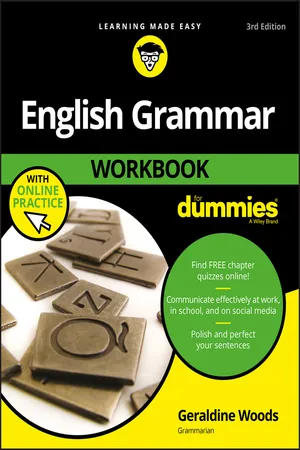
- English
- ePUB (mobile friendly)
- Available on iOS & Android
English Grammar Workbook For Dummies with Online Practice
About this book
Improve your English grammar
You have nothing to lose and everything to gain by using proper English language and grammar. The ability to articulate and communicate effectively is a valuable asset in all aspects of life. From writing a research paper to giving a presentation at work or just holding a casual conversation with friends or family, strong verbal and written skills are necessities in everyday communication.
English Grammar Workbook For Dummies is the perfect solution for sharpening the tools in your grammar kit, with lessons and plenty of practice opportunities to help reinforce learning.Whether you need to brush up on the finer points of punctuation, need help making sense of those pesky parts of speech—or anything in between—this approachable guide makes it fast and easy.
• Find FREE quizzes for every chapter online
• Handle pronouns with grace
• Master plurals and possessives
• Improve your proofreading skills
Everyone benefits from using proper grammar and speech, and now you can too!
Frequently asked questions
- Essential is ideal for learners and professionals who enjoy exploring a wide range of subjects. Access the Essential Library with 800,000+ trusted titles and best-sellers across business, personal growth, and the humanities. Includes unlimited reading time and Standard Read Aloud voice.
- Complete: Perfect for advanced learners and researchers needing full, unrestricted access. Unlock 1.4M+ books across hundreds of subjects, including academic and specialized titles. The Complete Plan also includes advanced features like Premium Read Aloud and Research Assistant.
Please note we cannot support devices running on iOS 13 and Android 7 or earlier. Learn more about using the app.
Information
Building a Firm Foundation: Grammar Basics
Tailoring Language to Suit Your Audience and Purpose


Climbing the Ladder of Language Formality
- c u in 10 (friendspeak)
- There in ten minutes. (conversational)
- I will arrive in ten minutes. (formal)
- Friendspeak breaks some rules of formal English on purpose, to show that people are comfortable with each other. Friendspeak shortens or drops words and often includes slang and references that only close friends understand. (That’s why I call it “friendspeak.”) No one has to teach you this level of English. You learn it from your pals, or you create it yourself and teach it to your buddies.
- Conversational English sounds relaxed, but not too relaxed. It’s the language equivalent of jeans and a T-shirt. Conversational English is filled with contractions (I’m instead of I am, would’ve instead of would have, and so forth). Not many abbreviations appear in conversational English, but you may confidently include those that are well established and widely understood (etc., a.m., p.m., and the like). You may also see acronyms, which pluck the first letter from each word of a name (NATO for the North Atlantic Treaty Organization or AIDS for Acquired Immune Deficiency Syndrome, for example). Conversational English may drop some words and break a few rules. The example sentence for conversational English at the beginning of this section, for instance, has no subject or verb, a giant no-no in formal writing but perfectly acceptable at this level of language.
- Formal English is the pickiest location in Grammarland. When you speak or write in formal English, you follow every rule (including some you never heard of), avoid slang and abbreviations, and trot out your best vocabulary.

Table of contents
- Cover
- Title Page
- Table of Contents
- Introduction
- Part 1: Building a Firm Foundation: Grammar Basics
- Part 2: Clearing Up Confusing Grammar Points
- Part 3: Mastering Mechanics
- Part 4: Going Above and Beyond: The Finer Points of Grammar and Style
- Appendix: Grabbing Grammar Goofs
- About the Author
- Connect with Dummies
- Index
- End User License Agreement